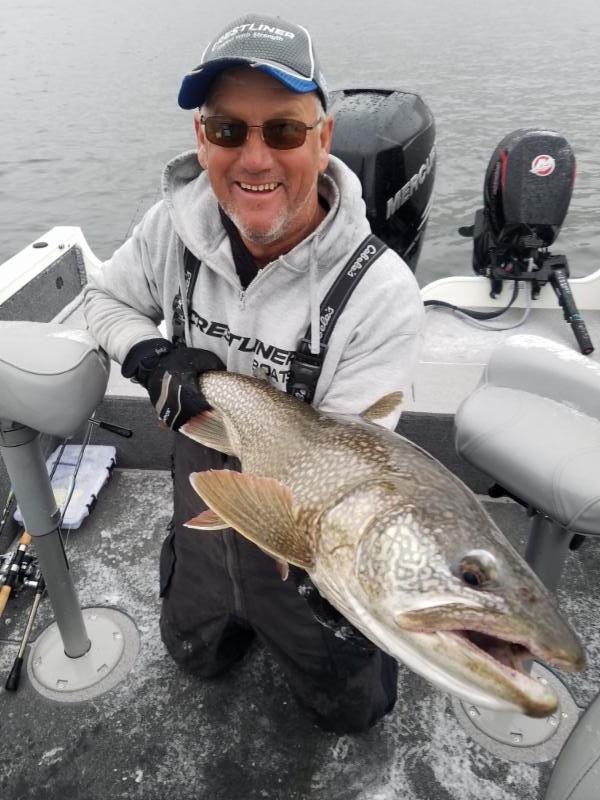 Lake trout are hard-fighting, great-tasting gamefish often misunderstood by the masses. If you’d like to catch more lakers this summer, factor these five facts from veteran trout guide Bernie Keefe into your fishing strategies.
Lake trout are hard-fighting, great-tasting gamefish often misunderstood by the masses. If you’d like to catch more lakers this summer, factor these five facts from veteran trout guide Bernie Keefe into your fishing strategies.Frontal Assaults
Cold fronts give walleyes and other fish species lockjaw, but not lake trout. “Most people don’t realize lake trout don’t care about fronts, they just keep on eating,” says Keefe. “I’ve had some of my best days in cold, bluebird conditions following a major front.”
Cold fronts give walleyes and other fish species lockjaw, but not lake trout. “Most people don’t realize lake trout don’t care about fronts, they just keep on eating,” says Keefe. “I’ve had some of my best days in cold, bluebird conditions following a major front.”
Keefe notes that many anglers flock to trout lakes when a front is coming. “They hope the approach of a storm fires up the trout,” he says. “But in many cases, the fishing is only average. The real action comes when the storm is hitting and continues after the front passes through.”
As a bonus to post-frontal fishing, Keefe says he often has the lake, and the lake trout, all to himself. “People assume lakers will behave like walleyes and the fishing will be tough, so they stay home,” he explains. “This reduces boat traffic and pressure, which helps improve the fishing even more.”
Pressure Points
On the flip side, an influx of anglers can wreak havoc on the action. “Fishing pressure is the number one bite killer for lake trout, bar none,” says Keefe.
On the flip side, an influx of anglers can wreak havoc on the action. “Fishing pressure is the number one bite killer for lake trout, bar none,” says Keefe.
“If you see boats working a spot, don’t waste your time on it,” he adds. “Those fish have been educated. You might get a bite, but your odds of a banner day are more in your favor if you find a new spot with fresh fish.”
Manage Success
In a similar vein, Keefe cautions against overfishing a hotspot. “Particularly with trophy-sized lake trout, if you’ve got a good bite going in a certain area, such as a point, limiting your catch to two or three trout per trip can extend the spot’s productivity,” he says.
In a similar vein, Keefe cautions against overfishing a hotspot. “Particularly with trophy-sized lake trout, if you’ve got a good bite going in a certain area, such as a point, limiting your catch to two or three trout per trip can extend the spot’s productivity,” he says.
“If you catch more big fish than that off it in one trip, there’s a pretty good chance you’ll burn it for future trips,” he continues. “It’s almost like you need to leave a few fish for seed. If you leave fish there, other trout will move in. If you clear the area, other trout are less likely to settle there.”
Keefe says the concept holds true with catch-and-release fishing, because released lakers often relocate after being pulled from a particular piece of structure.
Exit Strategy
Since lake trout often school by size, Keefe advises anglers seeking trophy trout not to tarry over pods of smaller fish.
Since lake trout often school by size, Keefe advises anglers seeking trophy trout not to tarry over pods of smaller fish.
“If you’re looking for lake trout 30 inches or longer, you have to be willing to walk away from a hot bite for 15- to 20-inch fish, because your chances of catching a big fish in the mix are pretty low,” he says.
“Big trout don’t hang around small trout for a couple of reasons,” he continues. “Number one is that the big fish eat the small fish, which makes for an uncomfortable relationship. Second, mature lakers are grumpy old farts that don’t like all the commotion of the younger crowd.”
Ideally, Keefe looks for the rod-bending action afforded by a school of hungry, 25- to 27-inch trout. “Trophy lakers will hang out with these size fish,” he says. “So you get to enjoy the fun of steady action, with a better than average shot at boating a big fish.”
Be Prepared
“If you want to catch a large trout, gear up accordingly,” he says. “Don’t bring a knife to a gunfight.”
“If you want to catch a large trout, gear up accordingly,” he says. “Don’t bring a knife to a gunfight.”
Keefe outfits clients with medium-heavy, 6- to 7-foot Fenwick Aetos and HMG rods that are light enough to fish all day, yet powerful enough to handle trophy trout.
Further boosting fighting power, Keefe spools with 14-pound-test Berkley FireLine mainline, and adds a 10-pound 100% Trilene Fluorocarbon leader for good measure.
“We also use TroKar 810 jig hooks, which are the strongest and sharpest hooks around,” he adds. “And keep an assortment of proven trout baits on hand, including Berkley Havoc, Gulp! and PowerBait tubes and minnow-shaped softbaits.”
Keefe also encourages trout seekers to master their on-board electronics. “Learn to adjust your sonar and interpret everything it’s trying to tell you,” he says. “My Lowrance sonar shows me fish other anglers miss. I can also read the trout’s moods, which makes it a lot easier to pull the plug on a fried group of fish and go looking for the next hot bite.”
